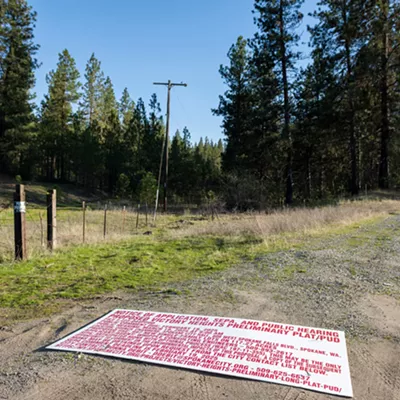Duncan On Trial
[
{
"name": "Broadstreet - Instory",
"component": "25846487",
"insertPoint": "4",
"requiredCountToDisplay": "4"
},{
"name": "Broadstreet - Empower Local",
"component": "27852456",
"insertPoint": "8",
"requiredCountToDisplay": "8"
},{
"name": "Broadstreet - Instory",
"component": "25846487",
"insertPoint": "12",
"requiredCountToDisplay": "12"
},{
"name": "Broadstreet - Instory - 728x90 / 970x250",
"component": "27852677",
"insertPoint": "18",
"requiredCountToDisplay": "18"
},{
"name": "Broadstreet - Instory",
"component": "25846487",
"insertPoint": "5th",
"startingPoint": "23",
"requiredCountToDisplay": "24",
"maxInsertions": 100
}
]
by Kevin Taylor & r & Joseph Edward Duncan III is scheduled to appear in a Coeur d'Alene courtroom on Tuesday, when Kootenai County prosecutors will argue there is enough evidence to show he should be tried on three charges of murder and three of kidnapping.
The hearing will be held under tight security and widespread media attention because it is the first step down a long road that may lead to a table with heavy straps and execution by the injection of poisons.
This is the rare case -- one federal investigator called it "the lightning strike" -- where mass murder, child sex abuse and other dark threads put Coeur d'Alene in the national eye. If it becomes a death penalty case, it could cost Kootenai County $2 millioin.
Duncan won't be walking this road alone. Attorneys -- both for the defense and the prosecution -- police, judges, witnesses, survivors will also make what is likely to be a long and torturous journey. And it won't end with the Kootenai County case -- once those trials are finished, the federal government will bring charges of kidnapping and murder.
The local and federal charges both carry the possibility of the death penalty, making every step high-profile and high-stakes.
An investigator with the Riverside, Calif., Sheriff's Department has been at the jail seeking to interview Duncan who has, at least twice since his arrest on July 2, invoked his constitutional rights to remain silent and to be represented by an attorney. A Kootenai County judge has already admonished local police and prosecutors to respect those rights, given the inevitable scrutiny -- and appeals -- as this case lurches toward resolution.
In a July 25 hearing, called to debate continued police attempts to speak to Duncan without first contacting his attorney, Chief Public Defender John Adams, 1st District Court Judge John Luster said, "On the question as to whether Mr. Duncan has asserted his rights under the Fifth and Sixth amendments; that is patently clear."
Once those rights have been invoked, Luster added, "Law enforcement is clearly prohibited under the Constitution from initiating contact to question him about those offenses or any other potential criminal offenses. The state should be well apprised of that."
But it's easy for the authorities to go overboard in their prosecution of this particular criminal. The crimes Duncan is accused of committing are hideous, with a level of violence and callousness never seen in North Idaho. Details of the crimes -- staking out a family's home at random with the use of night-vision goggles, beating three bound victims to death with a hammer, kidnapping two children to film and abuse them sexually, later killing one of them and burning the body -- have proven exceptionally disturbing to even veteran investigators.
"Killing three people in order to kidnap two children -- I have never heard of that before. This may be a first," says Jack Levin, director of the Brudnick Center on Violence and Conflict at Boston's Northeastern University. Levin has studied hundreds of cases of serial and mass murder during the last 20 years.
There is the surviving witness, an 8-year-old who has been hailed for courage and toughness as she recounts harrowing events.
There is the fact that Duncan was a registered Level III sex offender in North Dakota, creating a level of outrage and disgust that has swept the nation.
"We become so terrified of sex offenders, even though the rate hasn't increased," Levin says.
Tuesday, the 42-year-old Duncan will be accused in the May 16 beating deaths of Brenda Groene, 40; Mark McKenzie, 37; and Slade Groene, 13. If convicted, Duncan faces the possibility of death, or life in prison without parole, on each count.
Prosecutor Bill Douglas filed the kidnapping charges because the victims, although in their own home, had been bound and "held against their will." The kidnapping charges, weighed against everything else, seem almost frivolous, but act as more hooks into a suspect, says Tom Moss, U.S. Attorney for Idaho. After the trial in Kootenai County, the federal government will bring charges against Duncan for kidnapping and murder, Moss says.
These potential charges stem from allegations that Duncan, after killing the three people in the isolated home near Coeur d'Alene, abducted the two youngest residents -- Shasta Groene, 8, and Dylan Groene, 9. He is accused of taking the children to remote sites in Montana's Lolo National Forest where he sexually abused them for several weeks and later killed Dylan Groene.
Again, the penalties on these charges are death or life imprisonment without parole.
How many death penalties are enough? How many lifetimes in prison can someone serve without parole? As many as you can get, seems to be the mood.
"I've been down this road before," Moss says. As a county prosecutor in Idaho, Moss assisted the Bonneville County prosecutor in the 1987 conviction of Paul Ezra Rhoades on charges of kidnap and murder.
"He got two death penalties [along with five life sentences]. Four months later, I prosecuted him Bingham County, which was my county, on kidnapping and murder charges [from a separate crime], and he got two more death sentences," Moss says.
"You wonder why you need more death sentences. He earned them. He must be held accountable for what he did," Moss says.
And given the twists and turns in the prosecutorial road -- where there is intensive appellate court scrutiny of death penalty cases -- "You are covering your bases and making sure nothing goes awry," Moss says.
He notes that Rhoades was among the more than 100 death row cases around the West affected by a 2003 9th Circuit Court of Appeals ruling that juries, not judges, should decide if there are aggravating factors in a crime that would warrant the death penalty. Two of Rhoades' four death penalties were overturned. He remains on Idaho's death row, C-block, in the state's maximum-security penitentiary.
So where do you start? Especially when the sole survivor of the bloody ordeal is an 8-year-old. On July 2, six weeks after she and her brother vanished, Shasta Groene abruptly reappeared in Coeur d'Alene. At a Denny's restaurant near Interstate 90. Just before 2 in the morning. Sitting at a table with Joseph Duncan, who calmly waited for police to arrive and offered no resistance when he was arrested.
After the arrest, county sheriff's officials, state police and the FBI -- all of whom had investigated the beating deaths and abductions -- talked about where to take the court case.
Anywhere a case can be built that minimized testimony by Shasta Groene, seemed to be the consensus. That appeared to lean toward federal court, where investigators have recovered videotape and other documentary evidence they say links Duncan to the two children. The county case, on the other hand, seems largely built on statements made by Shasta Groene.
Douglas, the county prosecutor, would not say directly why his office wound up going first.
"The federal prosecutor deferred to us. I am not going to comment on that." Later, he added, "We do more cases involving child victims than any other office in Idaho, and Lansing Haynes [Douglas' chief deputy] has probably done more cases involving child victims than any other prosecutor in the state," Douglas said. "We have a skilled staff in regard to dealing with victims of tender years."
Moss says this: "We were in close contact with the county prosecutor. [Shasta] was one of the many issues we discussed. I expect the state will use her as a witness. She is a very tough, very amazing little girl, but nothing overrides the importance of protecting the child. It's certainly an important concern."
But in the end, Moss says, it mattered little which jurisdiction went first because both will bring charges.
"The fact we could have made a better case without her wouldn't have mattered. The state would still have prosecuted their case," Moss says. "This is a case where -- my goodness -- three people have been murdered, and you can't ignore that."
Comments? Send them totheeditor@inlander.com
The hearing will be held under tight security and widespread media attention because it is the first step down a long road that may lead to a table with heavy straps and execution by the injection of poisons.
This is the rare case -- one federal investigator called it "the lightning strike" -- where mass murder, child sex abuse and other dark threads put Coeur d'Alene in the national eye. If it becomes a death penalty case, it could cost Kootenai County $2 millioin.
Duncan won't be walking this road alone. Attorneys -- both for the defense and the prosecution -- police, judges, witnesses, survivors will also make what is likely to be a long and torturous journey. And it won't end with the Kootenai County case -- once those trials are finished, the federal government will bring charges of kidnapping and murder.
The local and federal charges both carry the possibility of the death penalty, making every step high-profile and high-stakes.
An investigator with the Riverside, Calif., Sheriff's Department has been at the jail seeking to interview Duncan who has, at least twice since his arrest on July 2, invoked his constitutional rights to remain silent and to be represented by an attorney. A Kootenai County judge has already admonished local police and prosecutors to respect those rights, given the inevitable scrutiny -- and appeals -- as this case lurches toward resolution.
In a July 25 hearing, called to debate continued police attempts to speak to Duncan without first contacting his attorney, Chief Public Defender John Adams, 1st District Court Judge John Luster said, "On the question as to whether Mr. Duncan has asserted his rights under the Fifth and Sixth amendments; that is patently clear."
Once those rights have been invoked, Luster added, "Law enforcement is clearly prohibited under the Constitution from initiating contact to question him about those offenses or any other potential criminal offenses. The state should be well apprised of that."
But it's easy for the authorities to go overboard in their prosecution of this particular criminal. The crimes Duncan is accused of committing are hideous, with a level of violence and callousness never seen in North Idaho. Details of the crimes -- staking out a family's home at random with the use of night-vision goggles, beating three bound victims to death with a hammer, kidnapping two children to film and abuse them sexually, later killing one of them and burning the body -- have proven exceptionally disturbing to even veteran investigators.
"Killing three people in order to kidnap two children -- I have never heard of that before. This may be a first," says Jack Levin, director of the Brudnick Center on Violence and Conflict at Boston's Northeastern University. Levin has studied hundreds of cases of serial and mass murder during the last 20 years.
There is the surviving witness, an 8-year-old who has been hailed for courage and toughness as she recounts harrowing events.
There is the fact that Duncan was a registered Level III sex offender in North Dakota, creating a level of outrage and disgust that has swept the nation.
"We become so terrified of sex offenders, even though the rate hasn't increased," Levin says.
Tuesday, the 42-year-old Duncan will be accused in the May 16 beating deaths of Brenda Groene, 40; Mark McKenzie, 37; and Slade Groene, 13. If convicted, Duncan faces the possibility of death, or life in prison without parole, on each count.
Prosecutor Bill Douglas filed the kidnapping charges because the victims, although in their own home, had been bound and "held against their will." The kidnapping charges, weighed against everything else, seem almost frivolous, but act as more hooks into a suspect, says Tom Moss, U.S. Attorney for Idaho. After the trial in Kootenai County, the federal government will bring charges against Duncan for kidnapping and murder, Moss says.
These potential charges stem from allegations that Duncan, after killing the three people in the isolated home near Coeur d'Alene, abducted the two youngest residents -- Shasta Groene, 8, and Dylan Groene, 9. He is accused of taking the children to remote sites in Montana's Lolo National Forest where he sexually abused them for several weeks and later killed Dylan Groene.
Again, the penalties on these charges are death or life imprisonment without parole.
How many death penalties are enough? How many lifetimes in prison can someone serve without parole? As many as you can get, seems to be the mood.
"I've been down this road before," Moss says. As a county prosecutor in Idaho, Moss assisted the Bonneville County prosecutor in the 1987 conviction of Paul Ezra Rhoades on charges of kidnap and murder.
"He got two death penalties [along with five life sentences]. Four months later, I prosecuted him Bingham County, which was my county, on kidnapping and murder charges [from a separate crime], and he got two more death sentences," Moss says.
"You wonder why you need more death sentences. He earned them. He must be held accountable for what he did," Moss says.
And given the twists and turns in the prosecutorial road -- where there is intensive appellate court scrutiny of death penalty cases -- "You are covering your bases and making sure nothing goes awry," Moss says.
He notes that Rhoades was among the more than 100 death row cases around the West affected by a 2003 9th Circuit Court of Appeals ruling that juries, not judges, should decide if there are aggravating factors in a crime that would warrant the death penalty. Two of Rhoades' four death penalties were overturned. He remains on Idaho's death row, C-block, in the state's maximum-security penitentiary.
So where do you start? Especially when the sole survivor of the bloody ordeal is an 8-year-old. On July 2, six weeks after she and her brother vanished, Shasta Groene abruptly reappeared in Coeur d'Alene. At a Denny's restaurant near Interstate 90. Just before 2 in the morning. Sitting at a table with Joseph Duncan, who calmly waited for police to arrive and offered no resistance when he was arrested.
After the arrest, county sheriff's officials, state police and the FBI -- all of whom had investigated the beating deaths and abductions -- talked about where to take the court case.
Anywhere a case can be built that minimized testimony by Shasta Groene, seemed to be the consensus. That appeared to lean toward federal court, where investigators have recovered videotape and other documentary evidence they say links Duncan to the two children. The county case, on the other hand, seems largely built on statements made by Shasta Groene.
Douglas, the county prosecutor, would not say directly why his office wound up going first.
"The federal prosecutor deferred to us. I am not going to comment on that." Later, he added, "We do more cases involving child victims than any other office in Idaho, and Lansing Haynes [Douglas' chief deputy] has probably done more cases involving child victims than any other prosecutor in the state," Douglas said. "We have a skilled staff in regard to dealing with victims of tender years."
Moss says this: "We were in close contact with the county prosecutor. [Shasta] was one of the many issues we discussed. I expect the state will use her as a witness. She is a very tough, very amazing little girl, but nothing overrides the importance of protecting the child. It's certainly an important concern."
But in the end, Moss says, it mattered little which jurisdiction went first because both will bring charges.
"The fact we could have made a better case without her wouldn't have mattered. The state would still have prosecuted their case," Moss says. "This is a case where -- my goodness -- three people have been murdered, and you can't ignore that."
Comments? Send them totheeditor@inlander.com
















